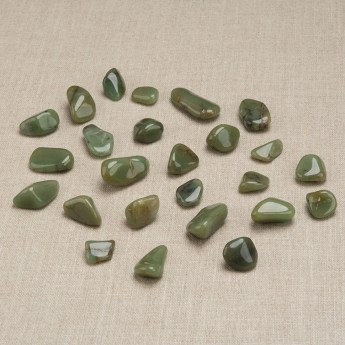Chalcedony: Properties, Facts and Photos

| Contents 1. What is Chalcedony? 2. Chalcedony Varieties 3. More Chalcedony Facts 4. Shop Chalcedony |
What is Chalcedony?
Chalcedony is a fine-grained cryptocrystalline variety of quartz. Minerals described as cryptocrystalline have crystals too small to be seen with the naked eye.
The correct pronunciation is 'kal~SED~uh~nee'.
Chalcedony tends to have a waxy lustre, is usually translucent, and can be found in white, grey, blue, or brown. Due to different impurities, stones can occur in many other colours.
Blue chalcedony is particularly popular as a decorative stone, but gemstone material is often dyed.
Graded 6.5 to 7 on the Mohs scale of hardness, chalcedony is relatively hard and can be found worldwide.
The finest grade chalcedony comes from India, Madagascar, Burma, Brazil, Mexico and the USA.
Varieties of Chalcedony
Jasper, agate, carnelian, onyx, chrysoprase and bloodstone are all varieties of chalcedony. The colour of carnelian comes from the presence of iron oxides.
Iron oxides are chemical compounds of iron and oxygen. Hematite and magnetite are the most common.
The dark red inclusions in bloodstone also come from iron oxides.
The colour of chrysoprase is caused by impurities of nickel.
Some of the lesser-known varieties of chalcedony include plasma, sard and sardonyx. Sard occurs in shades of light to dark brown, whilst sardonyx features bands of sard with white chalcedony.
Banded chalcedony, regardless of colour, tends to be known as agate. When bands are black, white, dark brown, or just one colour, it's known as onyx.
The main difference between agate and onyx is the bands. In onyx, the bands are parallel, while in agate, they're curved.
More Chalcedony Facts
The mineral chalcedony, which has been used for thousands of years, is believed to have been one of the earliest materials used for tools and weapons. Other varieties, including agate, flint, jasper, and petrified wood, were also widely used.
Chalcedony was considered a sacred stone by the Native American Indians and was used to promote stability within the tribe.
Chalcedony has been used throughout history for carvings, seals, and jewellery. It was believed to have protective properties, particularly against poisoning, and was often worn as an amulet. Chalcedony seals found at the Palace of Knossos, the largest Bronze Age site on the Greek island of Crete, have been dated to approximately 1800 BC.
Chalcedony seals found at the Palace of Knossos, the largest Bronze Age site on the Greek island of Crete, have been dated to approximately 1800 BC.
The name 'chalcedony' comes from the Latin word 'chalcedonius'. It's believed to come from the town of Chalcedon, near present-day Istanbul.
The Latin 'chalcedonius' comes from the Greek 'khalkēdōn'.
Article Pictures
The reddish-brown botryoidal chalcedony image at the top of our article is courtesy of James St. John. It's clickable and redirects to the original photo.
The blue chalcedony in our second photo was once part of our collection.
Pop-up photos: Magnetite, plasma agate - Courtesy of Stan Celestian. Nickel - Courtesy of Ron Wolf. Sard - Taken by Stone Mania. Blue chalcedony - Courtesy of James St. John.

















